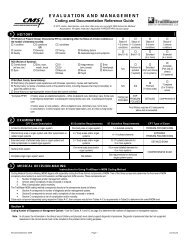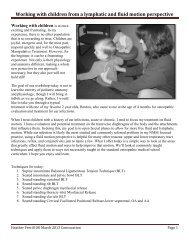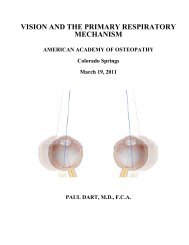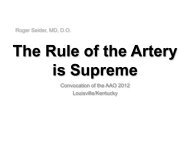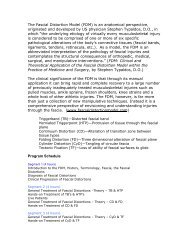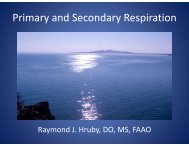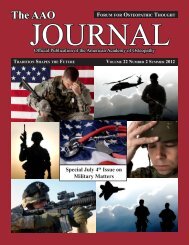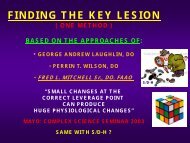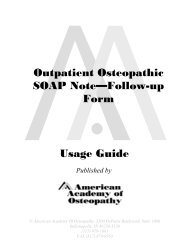AOA Protocols for OMT - American Academy of Osteopathy
AOA Protocols for OMT - American Academy of Osteopathy
AOA Protocols for OMT - American Academy of Osteopathy
You also want an ePaper? Increase the reach of your titles
YUMPU automatically turns print PDFs into web optimized ePapers that Google loves.
appropriate to create a "treatment plan" <strong>for</strong> <strong>OMT</strong>. Several different treatment techniquesmay be integrated <strong>for</strong> use in the same patient. Adjunctive modalities may be employed inthe total case management <strong>of</strong> the patient's condition.The choice <strong>of</strong> osteopathic manipulative technique is based on multiple factors. These includethe age and physical condition <strong>of</strong> the patient, and the effectiveness <strong>of</strong> previous <strong>for</strong>ms <strong>of</strong>treatment. The physician must also keep in mind his or her own experience and expertise ineach <strong>of</strong> the treatment methods, and must choose those that can be per<strong>for</strong>med effectively.Due to the complex interrelations <strong>of</strong> body systems, and the body's innate ability to makecompensatory changes during each treatment, tissues both adjacent to and remote fromthe area <strong>of</strong> primary involvement may require concomitant treatment.The three key components <strong>of</strong> an E/M service: history, examination and medical decisionmaking are essential in the decision making process and management <strong>of</strong> the patient prior tothe per<strong>for</strong>mance <strong>of</strong> subsequent <strong>OMT</strong>. There<strong>for</strong>e it is appropriate <strong>for</strong> an E/M service to beper<strong>for</strong>med at each follow-up patient encounter. An appropriate significant, separatelyidentifiable E/M service, documented according to the E/M Documentation Guidelines shouldbe provided and reported. This is all necessary in determining: If additional <strong>OMT</strong> needs tobe provided and if so, 1) What body regions need to be treated, 2) What <strong>OMT</strong> technique(s)should be utilized, and 3) If <strong>OMT</strong> needs to be augmented with other medical services/procedures.Basic Treatment ConceptsA. Patients who present with a dysfunctional somatic component to their condition maybenefit from <strong>OMT</strong>.B. The primary goal <strong>of</strong> using <strong>OMT</strong> is to enable the patient to return to health and optimizefunction.C. <strong>OMT</strong> should be per<strong>for</strong>med at the appropriate effective frequency as determined throughthe on-going process <strong>of</strong> medical evaluation and management.D. <strong>OMT</strong> should be per<strong>for</strong>med <strong>for</strong> the minimum appropriate duration. This can be defined asthat duration <strong>of</strong> time from the initiation <strong>of</strong> treatment which will result in continuedimprovement, and where additional treatment will not further benefit the patient.E. Subsequent treatments may be an appropriate response to unstable or recurrentconditions as part <strong>of</strong> the overall management <strong>of</strong> the patient's condition. Every attempt ismade to reach maximum improvement <strong>of</strong> the patient and <strong>OMT</strong> should be coupled with otherappropriate medical and/or surgical interventions. Occasionally, less frequent, periodictreatment may be utilized effectively to help continue maximum medical improvement. Thefrequency <strong>of</strong> such treatment should be consistent with the phase <strong>of</strong> the patient's disease ordysfunctional process as determined by on-going evaluation and management <strong>of</strong> thepatient's condition. 26Some stabilized conditions that acutely decompensate may require reinstitution <strong>of</strong> <strong>OMT</strong>. 27Subsequent evaluation and management in conjunction with <strong>OMT</strong> is appropriate <strong>for</strong> patients28, 29with long term conditions.
Passive physical medicine modalities should be combined with an active treatment programwhich emphasizes progressive exercises with a decreasing frequency <strong>of</strong> passive treatments.The modalities provided should be appropriate to the individual patient's presenting problemand their response to prior treatment. Prolonged application <strong>of</strong> physical rnedicine modalitiesbeyond the acute phase <strong>of</strong> treatment should be limited in frequency and number <strong>of</strong>modalities utilized and should not be utilized as the sole <strong>for</strong>m <strong>of</strong> treatment.<strong>OMT</strong> ParametersThe guidelines below are meant to be used as a basic reference <strong>for</strong> appropriate osteopathicmanipulative treatment. They are not intended to set restrictive criteria that would overridean osteopathic physician's good judgment in comprehensive case management. Mostpatients should fall within the parameters below and there should be sufficient latitude <strong>for</strong>physicians with varying treatment styles and approaches. Some patients have additionalfactors which complicate successful completion <strong>of</strong> treatment. Among these factors are theseverity <strong>of</strong> the illness, duration or chronicity <strong>of</strong> the condition, as well as the existence andextent <strong>of</strong> comorbidities. 30Acute, Post-acute and Chronic refer to the phase <strong>of</strong> illness determined by the timeelapsed from the onset <strong>of</strong> symptoms. Date <strong>of</strong> injury, diagnosis, acute exacerbation orsurgery must be taken into consideration. 31Initial refers to the interval during which <strong>OMT</strong> is first utilized by a particular physician inthe treatment process regardless <strong>of</strong> the phase. The initial use <strong>of</strong> <strong>OMT</strong> may occur through itsuse by the primary treating physician in the acute illness, or it may be first used insubsequent phases <strong>of</strong> the illness through appropriate referral. Patients are treated morefrequently during the first several encounters regardless <strong>of</strong> the phase <strong>of</strong> the illness, with asubsequent decrease in treatment as appropriate.Subsequent refers to the treatment period following the initial interval <strong>of</strong> treatment by aparticular physician within an illness phase, and as continuing treatment throughsubsequent phases patient's progress to recovery or maximum medical improvement.Treatment <strong>of</strong> Recurrent Problems: If a patient has multiple recurrent episodes related totheir original complaint within one year, it should not be classified or treated as an acuteproblem. In this circumstance, it would be classified as a recurrent problem and secondaryassessment and treatment methods should be used with an emphasis on active therapy andprevention strategies. Additional treatment may be necessary if repeated ef<strong>for</strong>ts towithdraw from treatment results in significant deterioration <strong>of</strong> clinical status. Patients withrecurrent problems may require additional evaluation and interventions <strong>for</strong> psychosocial andergonomic factors which may be contributing to the recurrent nature <strong>of</strong> the problem. Ahistory <strong>of</strong> previous episodes <strong>of</strong> similar complaints should be considered as well as possiblecontributory factors such as chronic pain, depression, alcohol/substance abuse, smokingand extreme obesity. Supervised changes in physical activity and lifestyle should also heconsidered.The routine scheduled provision <strong>of</strong> osteopathic manipulative treatment (<strong>OMT</strong>) would not beconsidered appropriate in the absence <strong>of</strong> acute or chronic problems.Parameters For Frequency Of Application Of Osteopathic Manipulative Treatment
TREATMENT INTERVALSPhase <strong>of</strong> Illness* Acute Post-acute Chronic0-12 weeks 12 wks - 6 months 6 months or longer1-3/wk <strong>for</strong> 2 wks1-2x/wk <strong>for</strong> 2 wksInitial1-3x/wk <strong>for</strong> 2 wksSubsequent2-3x/wk <strong>for</strong> 2 wks1-2x/wk1-2x/wkOnce every 1-2wks*Phase <strong>of</strong> Illness is defined as the time elapsed from onset <strong>of</strong> symptoms.SOAP Note - New Patient ExampleSA patient complains <strong>of</strong> low back pain that began 3 days ago after he lifted a heavy object.Cannot straighten up when walking. Pain with change <strong>of</strong> position. Denies radiation <strong>of</strong> pain;it stays along the low back and waistline. Denies areas <strong>of</strong> numbness. Com<strong>for</strong>table whenlying down. Aspirin helps some. Has used heat with some help. No prior history <strong>of</strong> back painor injury. Denies allergies. Medical/surgical history is unremarkable.O• Tenderness noted over lumbar and sacral regions• Inability to extend lumbar spine when standing• Flexion posture when standing• Muscle spasms noted in paraspinals <strong>of</strong> the lumbar region• Decreased range <strong>of</strong> motion <strong>of</strong> lumbar spine and sacrum was noted on active andpassive motion testing• Neurological exam normal
A1. Lumbosacral sprain. 846.02. Somatic dysfunction - lumbar, sacral 739.3 and 739.4P1. <strong>OMT</strong> (appropriate techniques used*), applied to the lumbar and sacral regions2. Continue aspirin3. No lifting, bending or twisting4. Follow up in two days to reevaluate patient progressCODING FOR THIS CASEEvaluation/management; new patient 99203-25<strong>OMT</strong> two body regions; lumbar/sacral 98925*See <strong>AOA</strong> Glossary <strong>of</strong> Osteopathic Terminology <strong>for</strong> appropriate techniques.SOAP Note - Established Patient ExampleSPatient is here <strong>for</strong> re-evaluation. He states that the pain has decreased in his low back andthat he can get around better. He states that he has no radiation <strong>of</strong> pain into his legs. Hedoes state that he feels stiff and achy if he tries to do his normal daily activities. He is stilltaking aspirin with some relief.O• Tenderness with palpation and stretch <strong>of</strong> the erector spinae muscles• Pain with extention and rotation left <strong>of</strong> L5• Pain along with right SI joint with sacral extension• No muscle spasms noted with active or passive range <strong>of</strong> motion• Negative neurological exam <strong>of</strong> lower extremitiesA1. Lumbosacral sprain/strain; improving 846.02. Somatic dysfunction - lumbar, sacral; improving 739.3 and 739.4P1. <strong>OMT</strong> (appropriate techniques used*), applied to the lumbar and sacral regions2. Instructed on proper posture when lifting
3. Increase home activities gradually and to tolerance4. Follow up if improvement does not continueCODING FOR THIS CASEEvaluation/management; established patient 99213-25<strong>OMT</strong> two body regions; lumbar/sacral 98925*See <strong>AOA</strong> Glossary <strong>of</strong> Osteopathic Terminology <strong>for</strong> appropriate techniquesSOAP Note - Established Patient ExampleSPatient ambulating, non-smoker with chief complaint <strong>of</strong> deep cough and with occasionalvomiting, x three weeks. Onset nasal congestion; hoarseness; cough; low gradetemperature (100-101 degrees). Almost dry cough with occasional clear sputum. Pain incenter chest with coughing and no radiation <strong>of</strong> chest pain. Patient did have right rib painwith deep inspiration and cough. Cough worse in PM with occasional insomnia. Occasionalslight chills and sweats.OTemperature = 100 degrees; blood pressure = 120/80; pulse = 92; respiration = 18.Chest- diffuse insp. rales (fine and course). Heart - RRR without murmur. H& ENT - nasalcongestion with TMs non--injected; pharynx-injected with cervical lymphadenopathy.Abdomen - non-tender, no splinting, negative Lloyds. Structural exam - resp diaphragmamplitude diminished with lateral rib restrictions R>L.Sternal tenderness with palpationT6-L1 (N) SB R R LC3-7 SB R R R AA R R OA SB R R LTentorium restricted with CRIA1. Pheumonia, prob mycoplasma 483.02. Somatic Dysfunction - head cervica, 739.0, 739.1, 739.2, 739.8, 739.9 thoracic,lumbar, rib cage, abdomen regions3. Strained anterior cervical fasciaPTreatment plan - Erythromycin 250 mg qid x 2 wksTessalon Perles: Two tablets q 6-8 hrs prn
Lab - CxR, CBC with diff, cold agglutinins<strong>OMT</strong> - head, cervical, thoracic, lumbar, rib cage, abdomen regions (s<strong>of</strong>t tissue and HVLA)Lymphatic pump; rib raisingCall in 24 hrs; return in one wk <strong>for</strong> re-eval.CODING FOR THIS CASEEvaluation/management; established patient 99214-25<strong>OMT</strong>, five to six body regions 98927SOAP Note - New Patient ExampleSPatient presents with a chief complaint <strong>of</strong> achy, dull pain in the upper thoracic and lowercervical region, radiating into the posterolateral right arm. Patient has been having stiffnessin the morning since then. He states the onset was two days ago, after golfing in coldweather. The symptoms have been gradually increasing since that time. The symptoms areaggravated while driving and working at his computer station; relieved when lying down. Hedenies anesthesias, parasthesias or weakness in the right fingers, hand or <strong>for</strong>earm. He hastaken Tylenol with minimum relief.PSH: Denies.PMH: Noncontributory.SH: Patient owns an insurance agency and spends several hours per day at a computerkeyboard.FH: Negative <strong>for</strong> rheumatologic problems.Present Medications: Tylenol. No known drug allergies.ROS: Cardiac, pulmonary and GI all negativeOB/P 122/70Pulse 64Respirations 18Weight 167Heart has a regular rate and rhythm with no murmurs. Lungs are clear to auscultationbilaterally. Neurologic DTRs are +2/4 in the upper and lower extremities bilaterally.
Sensation is intact and there is no evidence <strong>of</strong> weakness or atrophy in the upperextremities.Structural Exam: T1 is rotated and sidebent right. C6 and 7 are sidebent left. T3 is rotatedright with posterior displacement <strong>of</strong> the right 3rd rib. There is pain at the end point <strong>of</strong> range<strong>of</strong> motion <strong>of</strong> these areas. There are acute tissue texture changes and muscular hypertonicityin the upper right thoracic and lower cervical paravertebral muscles. Extension <strong>of</strong> the neckreproduces the patient's symptoms. The lumbar spine is sidebent left with secondary rightrotation and significant restriction at the thoracolumbar and lumbosacral junctions. Thesacral base declines to the right. 1.) Examination <strong>of</strong> the shoulders revealed negativeimpingement test, a negative drop arm test. 2.) The rotator cuff had normal motion bothactive and passive.A1. Somatic dysfunction - cervical, thoracic, costal, lumbar, sacral 739.1, 739.2, 739.4,739.8.2. Mild cervical nerve root irritation secondary to #1 above; suspect DJD. 353.2P1. <strong>OMT</strong> to above areas with excellent response.2. Rx - Lodine 400mg to be taken one b.i.d. with food.3. Recheck 1 week <strong>for</strong> signs and symptoms persist.CODING FOR THIS CASEEvaluation/management; new patient 99204-25<strong>OMT</strong> five body regions; cervical, thoracic, lumbar, sacrum, ribs 98927SOAP Note - Established Patient ExampleSPatient continues to experience achy and dull pain in the right lower cervical region,particularly with extension <strong>of</strong> the neck. It continues to radiate into the right lateral arm. Hehas experimented with some different positions <strong>of</strong> his car seat, which he feels has beenhelpful. He has tolerated the Lodine well and states that overall he fees somewhatimproved. Further work history reveals improper placement <strong>of</strong> video screen at computerstation and lack <strong>of</strong> wrist rest at keyboard.OB/P 126/64Pulse 64Respirations 18Cardiac and pulmonary exam again negative. DTRs are +2/4 in the upper extremitiesbilaterally. No weakness or atrophy in the upper extremity. Tl and T3 are again rotated rightwith right 3rd rib dysfunction and hypertonicity <strong>of</strong> the right rhomboid muscles. The lowercervical segments are again sidebent left with tightness <strong>of</strong> the short restrictor muscles on
the right. The lumbar spine is in better balance today with level sacral base. X-rays taken inthe <strong>of</strong>fice today reveal an uncovertebral osteophyte at the C5-6 level on the right, causingmild <strong>for</strong>aminal narrowing. Radiologist report pending.A1. Somatic dysfunction - cervical, thoracic and costal, with secondary muscularHypertonicity. 728.8, 739.1, 739.2, 739.82. DJD cervical spine, 721.03. Mild cervical nerve root irritation 353.2Secondary to #1 and 2 above.P1. <strong>OMT</strong> to above areas with good mobilization.2. Continue Lodine,3. Recommend changes in work station configuration,4. Re-evaluate in 1 week.CODING FOR THIS CASEEvaluation/management; established patient 99214-25<strong>OMT</strong> three body regions; cervical, thoracic, ribs 98926The development <strong>of</strong> this document by the <strong>American</strong> Osteopathic Association was promptedby the growing need among non-osteopathic peer reviewers and entities <strong>for</strong> guidance in theappropriate frequency and uses <strong>of</strong> osteopathic manipulative treatment (<strong>OMT</strong>). While thesematerials provide a framework, they are not absolute rules and should not be used to setabsolute restrictions or other restrictions criteria that would override an osteopathicphysician's pr<strong>of</strong>essional judgment on case management. As with all medical treatments,patients may present with a broad variety <strong>of</strong> complicating factors and physicians should beaf<strong>for</strong>ded sufficient latitude to apply varying treatment styles and approaches to patient care.The use or omission <strong>of</strong> any <strong>of</strong> the techniques described herein <strong>for</strong> the purposesindicated herein should not be construed as adherence to the standard <strong>of</strong> care orfailure to adhere to the standard <strong>of</strong> care. Finally, these materials are only a basicreference and can not substitute <strong>for</strong> the education and training <strong>of</strong> an osteopathicphysician. Use <strong>of</strong> the enclosed guidelines, accompanied by proper documentation from thephysician, should provide the reviewer with the in<strong>for</strong>mation necessary to make an accuratedetermination. For further in<strong>for</strong>mation please consult the osteopathic pr<strong>of</strong>essionâ€sstandard textbook: Foundations <strong>for</strong> Osteopathic Medicine, Robert C. Ward, DO, FAAO,Executive Editor, (Copyright 1997, Williams and Wilkins).<strong>American</strong> Osteopathic Association | Division <strong>of</strong> Socioeconomic Affairs




